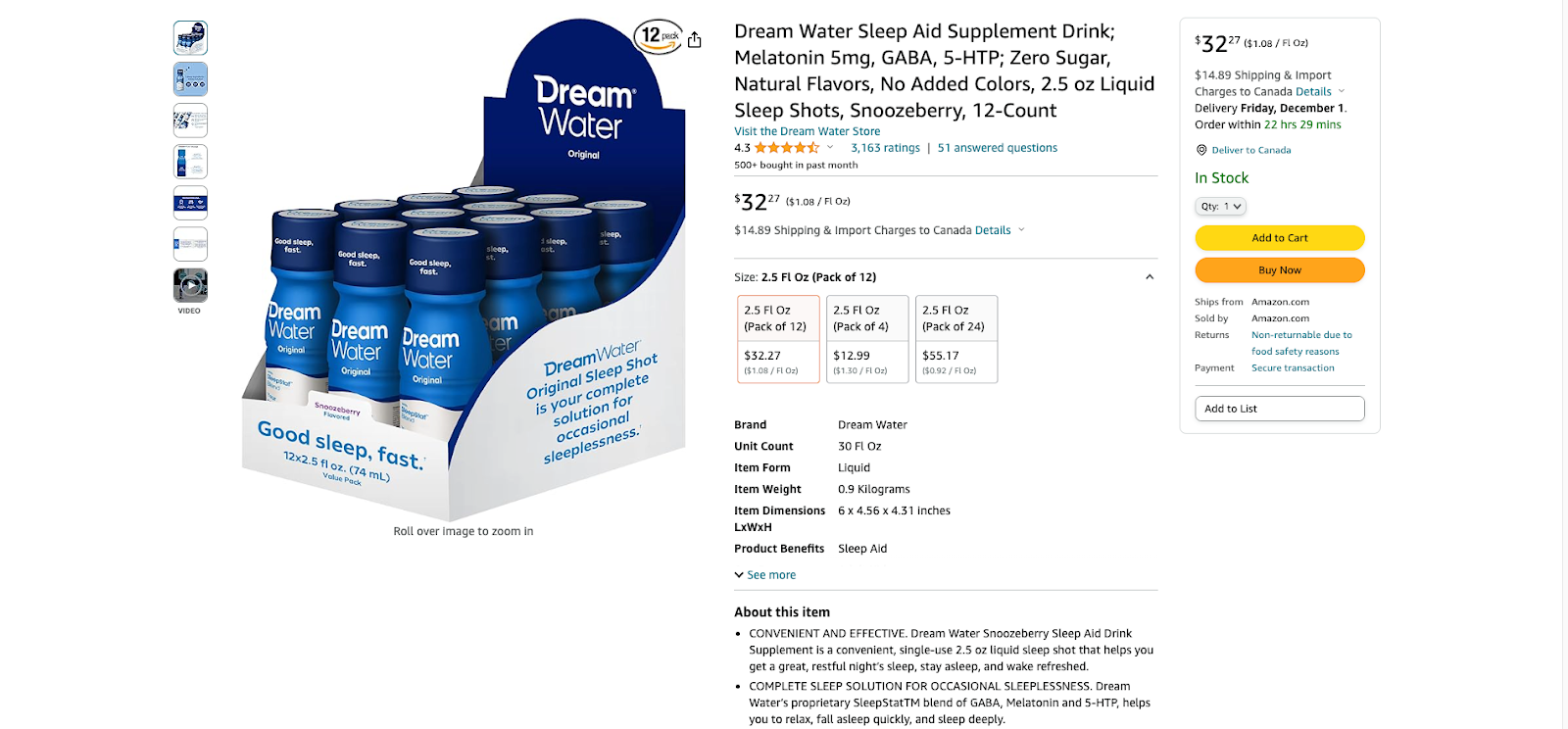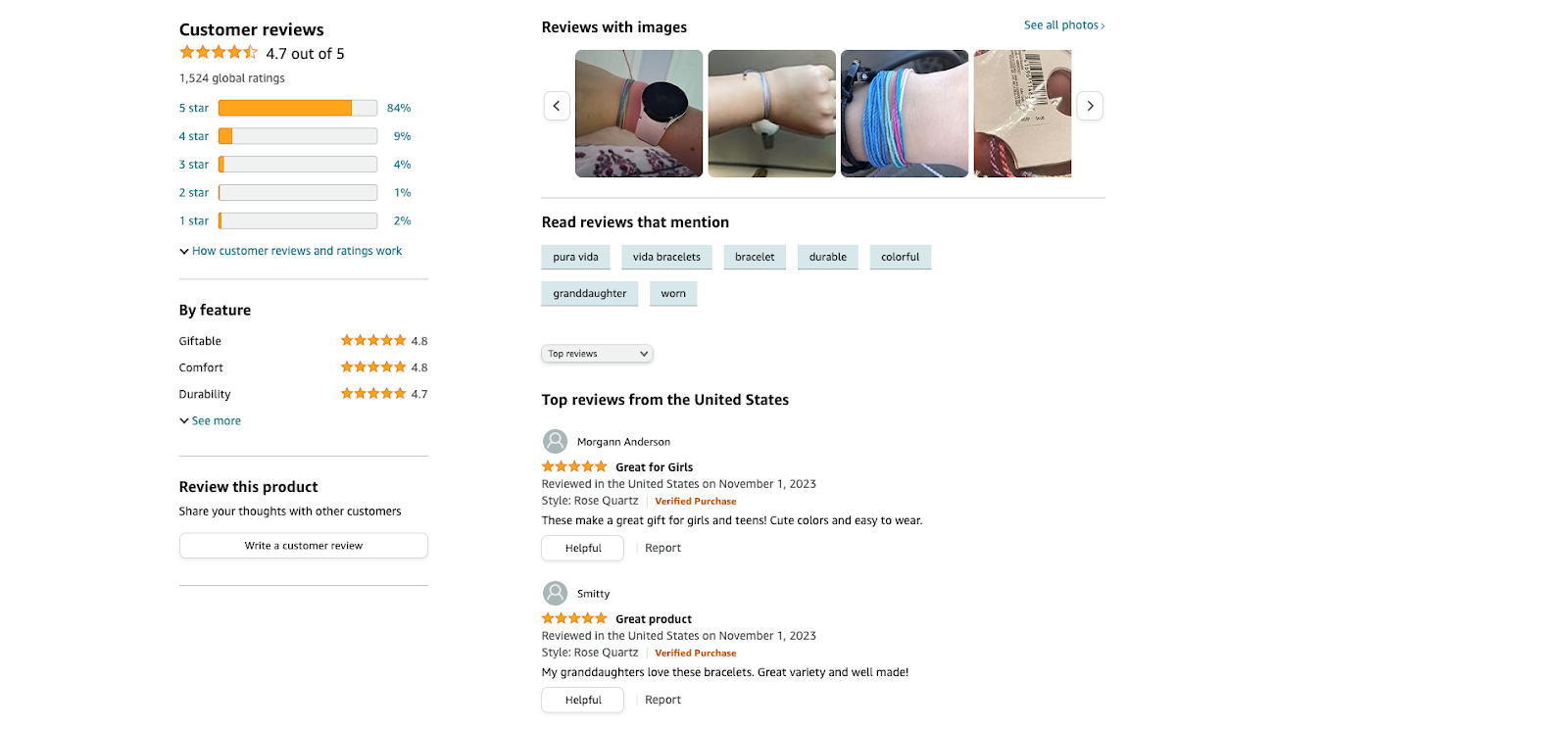So you’re looking to make money online and have started selling on Amazon. Now you’re ready to take your Amazon business to the next level—perhaps from side hustle to full-time business.
You’ve got two ways to grow: either by reaching more people (and selling more products), or squeezing more revenue from the products you’re already selling.
Selling on Amazon can help shoppers discover your brand, opening a productive additional sales channel for your Shopify store. Here’s what you need to know to maximize your sales on Amazon.
Tips for selling on Amazon
Here are strategies for marketing your product and maximizing revenue on Amazon.
1. Bundle products together
Product bundling is when you promote two or more products for purchase together, and it’s a proven way to make money on Amazon. Bundling products can help boost average order value so you can increase profit margins without having to make more sales. Often, merchants will offer a discount for product bundles.
Dirty Labs, for example, sells nontoxic laundry detergent products. It has a liquid soap available in two scents and a laundry booster powder—all three are available for purchase individually on its ecommerce website and Amazon store. Dirty Labs also bundles the products so shoppers can purchase both detergents or a detergent and the booster together in a single shopping cart item.
When considering which products to bundle for Amazon, look at your analytics to see which items are most often purchased together. You can then bundle these bestsellers—for the convenience of your shoppers.
When selling product bundles, make sure you integrate ecommerce systems so you can account for and manage inventory on Amazon, your Shopify store, and any other sales channels. For example, if you sell out of one of the products in the bundle, you want to have systems in place to hide out-of-stock items so customers are unable to purchase that particular bundle. Otherwise, you may risk sacrificing customer satisfaction.
2. Negotiate discounts with your supplier
Negotiating discounts with your wholesale supplier is one way to boost profitability and drive sales. If you have large or recurring orders, you are in a better position to leverage that knowledge to ask for bulk discounts. Any incurred savings can reduce your cost of goods sold (COGS).
Though suppliers may have pricing structures, these are typically negotiable. Don’t be afraid to push back if the numbers don’t work for your budget.
Remember, business is built on relationships. By maintaining a positive working relationship with your suppliers, you have an easier time conducting a transparent conversation about pricing. Show the supplier the benefit to them. Ask what you can do to make their job easier so they can provide you with a discount that meets your needs.
Learn more: What Is Amazon Dropshipping? How To Dropship on Amazon in 2024
3. Optimize your product listings and titles
There are millions of products and merchandise items available for purchase on Amazon. With so much competition, it’s crucial to create product listings and titles that stand out and capture the attention of your target audience. Keep the following in mind:
Titles matter
Write clear product titles that describe what the item is. Use descriptive copy that engages customers and captures your brand voice. The title gives a first impression to shoppers as to why they might want to make this purchase. Include your brand name, product use case, and primary benefit, if you have enough space. Remember to be detailed but brief.
Bullet points are your elevator pitch
In your product listings, hit key questions that customers need answered before they have to scroll. For example, mention facts about product warranties or customer service available to troubleshoot issues.
Product descriptions matter, too
Write product descriptions that are clear and concise with persuasive copy that conveys why a person should want to buy your item. Remember, customers typically skim, so brief descriptions likely have greater impact. Use your brand voice, and reiterate key selling points while mentioning any supporting facts that can help customers understand why they need to buy now.
Here’s an example of a product page for an Amazon seller that has optimized key areas for conversion. Notice that the title includes important product details, like the key ingredients, the size, and the amount of items in the order. The picture is clear and it has bullet points that are easy to skim and include important information the customers care about.

Avoid keyword stuffing
Keyword stuffing is the overuse of target keywords and phrases for search engine optimization (SEO) purposes. While it’s important to use terms that will help you rank for your category in Amazon search, keyword stuffing sacrifices readability and is not an SEO best practice. Instead, consider the customers’ perspective: What information is needed to convince them this item is worth purchasing?
Check your pages regularly
Amazon thrives on user-submitted content like product reviews, questions, and product images—and so do consumers. Visitors frequently spend time reading customer questions and reviews. With that in mind, regularly check customer questions and reviews for any gaps in your detail page content, and take the opportunity to respond to any concerns and address any confusion.
4. Get your pricing right
Finding the right pricing strategies for your products is crucial to stand out in an already crowded online marketplace where third-party sellers compete on factors including price.
Amazon associates pricing with your product category page and search visibility—if your prices are too high, you likely will be pushed further down in the results. But with some key considerations in mind, you can price your products competitively, while maintaining healthy profit margins:
Review the Amazon Marketplace Fair Pricing Policy
The Amazon Marketplace Fair Pricing Policy states that you can’t set a price “that harms customer trust.” Amazon offers examples of pricing practices that raise red flags, including:
- Using misleading reference prices
- Pricing significantly higher than recent prices offered on or off Amazon
- Selling bundles or multiple units for a higher price-per-unit than if sold individually
- Adding excessive shipping fees
You can face a potential account suspension for violation of this policy.
Win the Featured Offer
Amazon’s Featured Offer is a coveted position for new products because it gives extra visibility on search engine results pages. Since Amazon is an online marketplace, you can expect to be competing against other third-party sellers for first position on the list of sellers for your product.
Start monitoring your eligibility for the Featured Offer by going to “Inventory” under Seller Central and clicking “Manage All Inventory.” There, you will find product information such as SKU details and whether the product is eligible to be a Featured Offer. A detailed breakdown of the steps are available on Amazon.
Beyond setting base prices, you also want to consider sales and discounts. Such promotions can increase visibility and gain consumer reviews. Lightning Deals, price discounts, best deals, coupons, and buy one, get one (BOGO) offers are all opportunities to give a temporary discount that can increase sales.
Learn more: Rule the Market: 14 Retail Pricing Strategies
Remember to factor in Amazon fees when considering how much markup to add to your pricing to ensure you’re still turning a profit.
TIP: These pricing rules and policies apply even if you resell items you’ve purchased offline—a practice referred to as retail arbitrage.
Read more: Is Selling On Amazon Worth It For You?
5. Share product listings on social media
Many brands focus their digital marketing efforts on their ecommerce store or domain. While there’s value in directing traffic to your own site via Facebook ads, Google ads, PR campaigns, and other paid channels, the same tactics can also work to promote your products on Amazon. One of the easiest, cheapest, and potentially most effective places to start driving external traffic is your existing social media.
Here are a few tips when launching social media campaigns to market your Amazon products:
Start with your most active channels
If you’re wondering whether to advertise on Instagram or TikTok, remember that when it comes to social media marketing, the most effective channels are the ones you actually use. For best results, start by leveraging the social networks where you are most active and have the most followers.
Use interactive posts
To drive followers to your Amazon product page, you must create engaging social media ads and posts that inspire user action. These calls to action, or CTAs, can take various forms. Short videos, carousel ads, discount coupons, and contests or giveaways can be effective strategies for driving social media traffic to your Amazon listings.
Connect with influencers and affiliate marketers
If you don’t have a significant audience of your own, consider using the Amazon affiliate program or Amazon Influencer Program to increase your reach. Bloggers, vloggers, and other kinds of social media influencers use these Amazon services because they can collect an affiliate commission on any customer purchases that come from their custom link.
Learn more: Amazon Handmade vs. Etsy: Seller Pros and Cons
6. Encourage product reviews
Ecommerce reviews are crucial to the success of any ecommerce retail business, as they can bolster brand credibility, strengthen online presence, expand your customer base, and, most importantly, build customer trust.
Reviews on Amazon can impact other channels as well, including your Shopify site, since many customers tend to do research on Amazon first.
Pura Vida Bracelets has plenty of products on Amazon with reviews. These customer reviews include text as well as photos and provide social proof that the products are great and popular picks.

To drive more Amazon product reviews, follow up with customers via email. Amazon sellers are allowed to send post-sale emails to customers pertaining to a specific order, and there are automated services available to help you manage this process.
Remember: Amazon prohibits seller emails with marketing or promotional messages, links to external websites, or offers of incentives for positive reviews. But you are allowed to send a series of emails confirming the customer has received their order and requesting their feedback on your product.
While there are many best practices for ecommerce selling, consider starting with two emails: one to confirm receipt and/or shipment of the order, and a follow up a few weeks after the customer has received their Amazon product. Avoid writing spammy or aggressive emails, and give customers an opportunity to share negative feedback with you privately before writing a bad review.
7. Launch a Lightning Deal
Promotions, including Lightning Deals, are a way to sell units at an increased velocity, potentially leading to more reviews. Lightning Deals are flash sales that are featured on the Amazon Today’s Deals or Prime Day page, which are among the most frequently visited pages on Amazon.
Not only do they help increase your product’s discoverability, but they also help increase sales. This is because the product listing will often rise in ranking and search relevancy due to the increased units sold.
For big events such as Prime Day and during the holidays, Lightning Deals can be very successful in selling hundreds or thousands of units in a period of hours. It can also help new customers discover your brand, even if they don’t buy immediately.
8. Cross-sell your products on Shopify
You can set up an Amazon sales channel on Shopify to make it easier to list your products on the world’s largest marketplace and get your brand in front of millions of Amazon shoppers. Resources on the Shopify App Store such as the CedCommerce Amazon Channel can help you seamlessly integrate your Amazon accounts with your Shopify store.
And with Fulfillment by Amazon (or FBA), you can store inventory at—and fulfill orders from—an Amazon fulfillment center. Before setting up fulfillment services, you must first have an Amazon Seller Central account. Tools in Amazon Seller Central allow Shopify merchants to create Amazon product listings directly in Shopify, sync inventory across both sales channels, fulfill Amazon orders in Shopify, and track sales from both channels in one place.
You can also sync all your sales data across other channels, including sales in retail stores and on platforms like Etsy, Walmart, and eBay.
Learn more: How To Sell on Amazon in 6 Essential Steps
9. Maximize exposure with Amazon Advertising
Amazon Ads offers the opportunity for you to invest in digital ads, regardless of your budget (sponsored products are cost per click, so you pay based on ecommerce traffic, or clicks). The benefits of this type of paid advertising are that it allows the flexibility to leverage various types of ads to expand your customer reach, strengthens brand visibility, and captures important customer data and analytics. Among the features of Amazon Ads are:
Increased product visibility, for example, can translate into greater sales and revenue. And you can target ads to your ideal customer’s needs based on search keywords and similar items from their search.
Sometimes, Amazon may offer incentives for new sellers, such as $50 in free clicks.
10. Invest in ecommerce marketing campaigns
In ecommerce, marketing campaigns are one of the best ways to increase the visibility of your products and brand. You can invest in email marketing, product launches, and other types of marketing campaigns to help new and repeat customers find your Amazon products page. If part of your campaign strategy includes integrating Amazon into your Shopify store, this too can be a seamless way to raise brand awareness—and sales—so shoppers can find your items.
11. Create engaging content
Creating engaging content can help attract customers to your Amazon store if they are not already aware that you have one. You can accomplish this goal by creating content for your social media channels and website to drive external traffic. Once shoppers arrive at your Amazon store, take steps to ensure they have the best customer experience possible.
Make sure there is a cohesive brand experience across channels. For example, your brand’s color palette, font style, and imagery should be consistent from website to storefront. Also, build a connection with customers by telling your brand story. You can include this in an “About Us” section of your store or through visual storytelling on your store’s homepage through a combination of text, photos, and video interspersed with your products.
Market your business with Shopify’s customer marketing tools
Shopify has everything you need to capture more leads, send email campaigns, automate key marketing moments, segment your customers, and analyze your results. Plus, it’s all free for your first 10,000 emails sent per month.
Discover Shopify’s customer marketing tools
12. Use high-quality product photography
Photos are crucial when selling online, and so is using high-quality product photography. Your main product image should clearly show what the product is. Additional product images can provide more angles and incorporate a mix of contextual lifestyle imagery. You might also consider providing graphics or images of specific features, ingredients, or sizing information.
Remember to do your research on the best practices for ecommerce photography, as quality imagery can influence consumer trust in your brand and, ultimately, impact shoppers’ willingness to buy.
13. Study the competition
Some of the best insight for what to do when selling on Amazon can come from studying the market competition. Which brands are regularly awarded top-seller badges for their products? What are the top comments—compliments and complaints? What keywords are used in competitor product descriptions? How are they pricing comparable products?
Taking a close look at these details and answering these questions can help you assess how to best position your brand on Amazon and improve your own product listings and pages in relation to competitors.
14. Don’t try to game the system
Even if you want to know how to make money on Amazon as a form of part-time, passive income, you have to put in the work upfront. Instead of trying quick hacks to game the system, focus on what you would want to see if you were the customer. The most successful Amazon entrepreneurs have clear and descriptive pages, competitive pricing, reputable and high-quality reviews, and are trustworthy and responsive sellers.
15. Build on your existing Amazon relationship
If you already have a relationship with Amazon because you run an Amazon US store and have a Professional Services account, then consider tapping into the resources the online marketplace offers businesses in good standing. Amazon’s Strategic Account Services assigns you an account manager who takes on tasks to help your business succeed and grow. Among the support services you can expect are:
- Early access to special coupon deals
- Personalized growth strategies and other insights
- Advice about merchandising and advertising efforts
- Monthly business plan and goals review
There is no preset fee for this service, as it’s customized to the individual business. If interested in this service, you are required to make a commitment of at least three months.
Tips for selling on Amazon FAQ
Can you realistically make money on Amazon?
Yes, according to a 2023 survey by Jungle Scout, about 56% of Amazon sellers make $10,000 or less in sales monthly, and the highest-paid sellers make up to $250,000 a month in sales.
What are some strategies for making money on Amazon?
Fifteen strategies for making money on Amazon are:
- Bundle products together.
- Negotiate discounts with your supplier.
- Optimize your product listings and titles.
- Get your pricing right.
- Share product listings on social media.
- Encourage product reviews.
- Launch a Lighting Deal.
- Cross-sell your products on Shopify.
- Maximize exposure with Amazon Advertising.
- Invest in ecommerce marketing campaigns.
- Create engaging content.
- Use high-quality photography.
- Study the competition.
- Don’t try to game the system.
- Build on your existing Amazon relationship.
How do I make money on Amazon?
A few key steps for making money on Amazon include:
- Figure out what you’ll sell.
- Choose a plan.
- Create an Amazon seller account.
- Understand Amazon’s cost structure.
- Learn how to use Amazon Seller Central.
- Choose your fulfillment option.
- List your first product.
To learn more about how to make money on Amazon, check out: How To Sell on Amazon in 6 Essential Steps.




